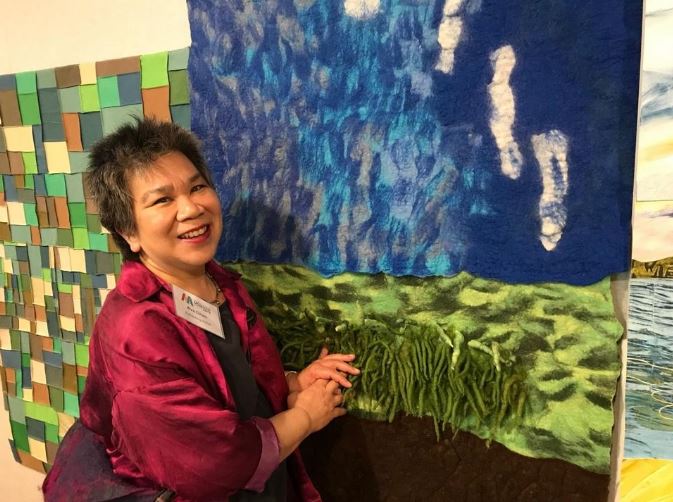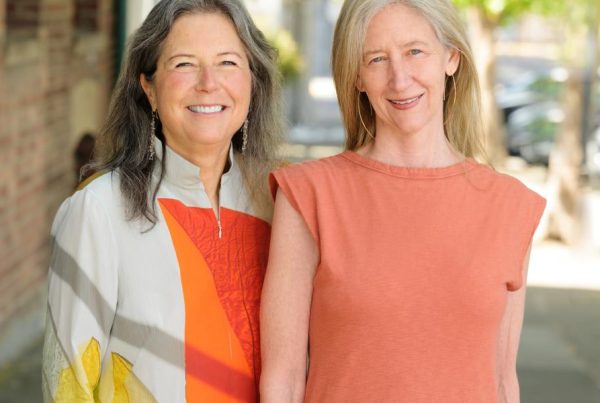WATERTOWN – Unlike other art shows, visitors can touch, probe, sniff and listen to striking works by visually impaired and sighted artists in an exciting multisensory exhibition at the Mosesian Center for the Arts.
Inviting visitors to explore original works through their fingertips and more, “Please Touch The Art” adds new dimensions to viewers’ encounters with 52 unique pieces made by 40 artists. Each has elements that complement traditional approaches to experiencing art.
Like the blind, visually impaired and sighted artists whose work is on display, this thoughtful exhibit features art that can be enjoyed through all the senses by all kinds of visitors.
Keep your hands off Monet’s water lilies hanging in a frame in Boston!
But try petting Cindy Lu’s “Fuzzy Logic,” a biomorphic sculpture made from plastic pipettes used in medical research, that resembles pillow-sized sea anemone that responds to your touch with sounds like gentle rain.
Comprising a hanging set of concentric bronze circles of increasing diameter, blind sculptor Aaron McPeake’s “Six Rings” can be touched and rung like a gong, offering both tactile and auditory responses to visitors’ hands.
Recalling her own time as a wheelchair user, Maryan Amaral’s “Integrated Abilities Dance” is a three-dimensional acrylic painting that lets viewers change the positions of movable “wheelchair” and “stand-up” dancers fixed to the canvas in ways that let visually impaired and sighted visitors change the scene like stage directors.
Juried and curated by Georgina Kleege, a professor of English and Disability Studies at University of California, Berkeley this exhibit surprises and satisfies on virtually every level nudging – even shoving – visitors to rethink how to look at art, what it feels like to be visually-impaired and the broader meaning of disability.
In the call for submissions, Kleege, who is blind, informed potential contributors “Please Touch The Art” would “invite sighted and visually impaired visitors to go beyond looking at artwork and encourage them to use their sense of touch to experience each piece.”
Noting most museums prohibit people from touching art, Kleege hopes visitors used their sense of touch to experience exciting works “in conjunction with or instead of sight.”
“People want to touch art but it’s often not allowed. There are different modes of communication,” she said. ”… You can touch these pieces with your fingertips, your whole hands, grasp it, manipulate it. Engage the art in different ways and try to make sense how the different parts are working together.”
“Much of the work is whimsical and playful but many pieces elicit other emotions,” she said. “They are meditative, mysterious, even mournful. … The work chimes, rattles, purrs, emits music and poetry.”
Matt Jatkola, creative services manager for the Mosesian Center, is the exhibition’s co-curator.
Like several other visitors, George Silvas was intrigued by the varied sensations of probing Rosalyn Driscoll’s multilevel “Table” and feeling the steel, stone, leather, wood, resin, rope, shell and copper components that went into its construction.
“I’m discovering how much I can see with my fingers,” said the software engineer from Bourne. “It’s exciting for me to explore how it was made and imagine what that says about the artist.”
“Sometimes vision can be a sensory bully,” said the Brookline resident. “But you can get lots of special information from touch.”
Visitors looking at and feeling Laura Klausmeyer’s engaging work wondered how the visually-impaired artist wove thousands of white cotton tee-shirt strips into a shaggy 46-by-36-inch rug titled “XO.”
“I can feel it and can feel all the pieces that went into it,” said Phyllis Albaugh, of Brookline “But it’s beyond me how she made it without hardly being able to see what she was doing.”
Newton-resident Lorena Delgado ran her hands along the purple chiffon ribbons and hand-dyed raffia that Klausmeyer wove into the rug, exclaiming, “I wish I could see as well with my eyes as this artist does with her hands.”
Speaking from her home in Wichita, Kansas, Klausmeyer said creating craft works like the rug lifts her spirits.
“I think it’s pretty cool to make something and then have it seen in another state,” she said. “It’s fun to try new things.”
Klausmeyer credited Sarah Stewart, an arts instructor for Envision, for inspiring her over the last two years to “try new things” such as mosaics.
A not-for-profit Wichita-based organization, Envision seeks to improve the quality of life of people who are blind or visually impaired by offering programs for students, youth and seniors including sports, music, camping and digitally-recorded books.
Stewart said the increased access to the arts for the blind and visually-impaired encourages vital social skills and self-expression.
Many works in the show blur the boundaries between painting, sculpture, and mixed media in novel ways.
In his singular “Ferris Haiku,” Michael Kolitsky, of Ocean City, NJ, ingenuously transformed poetry into a tactile experience by presenting Japanese-style poems in a miniature rotating Ferris Wheel form that can be listened to or even lets visitors record their own poems.
In their ambitious collaborative work, “Out For A Walk,” five fiber artists from the Surface Design Association created a paneled installation featuring different methods and materials, including wool, silk, paper and hand-dyed reeds to offer a multi-sensory tactile extravaganza.
Those considerations were partially inspired by the proximity of Perkins School for the Blind in Watertown and the increasing diversity of its visitors and artists to the Center.
To assist differently abled visitors enjoy the exhibit, it offers large print and Braille descriptive wall labels for all art on display, large print and Braille guide books, a guided audio tour of the show and tactile maps of the building.
She added that about 75 percent of the artists in the show are local residents.
“We really wanted different ways to engage new audiences and artists,” said Ruggles. “I’ve dreamed about an exhibit like this that engages all types of artists and visitors. As an institution, it allows us to be more mindful of universal participation.”
Source: Please touch this art at Watertown’s Mosesian Center













